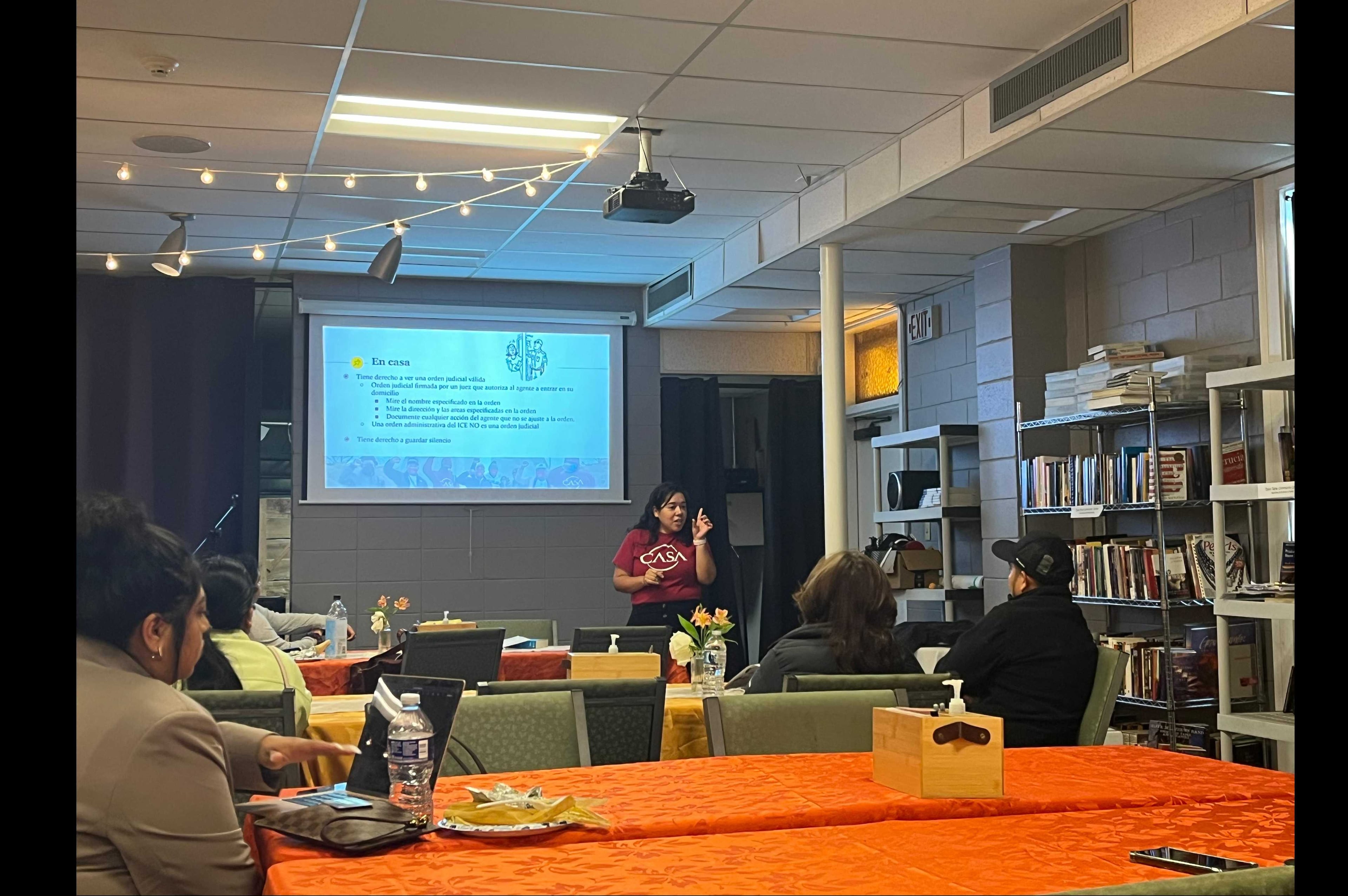Georgia educators wait and see how federal cuts will hit schools

As the new school year kicks off in metro Atlanta, school officials are facing a tidal wave of changes from Washington, D.C. Despite new information coming out nearly every day about how the Trump administration is changing education in the U.S., state and local school officials are still in a wait-and-see mode.
“We have minimal information at this time,” a spokesperson for the Georgia Department of Education said when The Atlanta Journal-Constitution requested to interview State Superintendent Richard Woods about changes at the federal level. “(We) don’t want to speculate.”
In the six months since Donald Trump was sworn into office, that’s been a common refrain in education.
From the initial flurry of executive orders intended to stamp out diversity, equity and inclusion; to tariffs that could affect schools’ ability to purchase technology or building supplies; to layoffs in the U.S. Department of Education; to lawsuit after lawsuit challenging the moves of the executive branch; to cuts to Medicaid and SNAP and student financial aid and academic research; to the freezing ― and unfreezing ― of billions in federal funds, the blizzard of changes have created uncertainty among some Georgia educators.
“It’s kind of unsatisfying but we just don’t know a lot about how this is all going to play out right now,” said Ross Rubenstein, a professor and distinguished chair in educational and community policy at Georgia State University.
Cuts keep coming
Educators were notified on July 1 that the U.S. Department of Education was freezing nearly $7 billion in federal funding scheduled to come to schools ― including more than $200 million earmarked for Georgia. The funding covered after-school programs, teacher training and programs for English-language learners and migrant students.
Three in four superintendents nationwide said they would have to cut academic services for students without the funding and half said they’d have to lay off personnel, according to a survey by the School Superintendents Association. But by July 25, the news came that the department would be releasing the funds.
“This is welcome news for Georgia’s students, families, and educators as we begin a new school year,” Woods said in a statement. “To lead effectively, we must have timely and reliable access to resources approved by Congress and signed into law by the President.”

Though the $6.8 billion in federal funding was restored, some coming changes could present major challenges for schools and students.
President Donald Trump signed the One Big Beautiful Bill Act ― or as detractors call it, the “big bad bill” ― on July 4. It institutes a slate of cuts over the next few years that will affect schools and children.
Cuts to SNAP benefits and Medicaid mean children will have less access to free meals and health services in schools. Borrowers will have fewer repayment options for their student loans, and a lifetime cap on the amount you can borrow will mean low-income students will have fewer higher education opportunities. The creation of a first-of-its-kind federal voucher program will mean more tax revenue flowing to private schools, if Georgia opts in to the program.
The left-leaning Georgia Budget and Policy Institute called it “one of the most regressive federal bills in U.S. history.”
And that’s separate from cuts that could be coming in the regular federal budget process. The White House proposed major cuts to education funding for the fiscal year that begins Oct. 1, including $4.5 billion from programs for rural education, literacy education, students experiencing homelessness and more. Lawmakers likely won’t be discussing the education budget until September, Politico reported.
Critics say the cuts to the U.S. Department of Education’s workforce will drastically hurt offices that manage data and research that helps educators monitor student performance, such as the Institute for Education Sciences and the National Center for Education Statistics. And some parents have already complained that staff cuts mean their civil rights complaints are less likely to be resolved.
Conservatives who support Trump’s promise to dismantle the Department of Education believe states and local school districts are better positioned to meet students’ needs than the federal government.
“The United States spends more money on education by far than any other country, but yet we rank near the bottom of the list in terms of success,” Trump said in March.

‘A different feel’
Experts say cuts of this magnitude are not unprecedented.
During the 2008 housing crash, known as the Great Recession, schools were hit hard by loss of revenue when people couldn’t pay their mortgages or taxes. Between 2010 and 2015, the state withheld at least $1 billion in education funding each year, according to a GPBI analysis. Lawmakers and education officials still talk about the “austerity cuts.”
Districts dealt with it by furloughing staff, increasing class sizes, cutting art and music programs and shortening school calendars.
“This is the first time since the end of austerity that districts have struggled with funding cuts in this way,” said Margaret Ciccarelli, the director of legislative services at the Professional Association of Georgia Educators.
Georgia State Board of Education Chair Stan DeJarnett said it’s not a direct comparison. While the current financial situation is not “unprecedented,” it’s different from 15 years ago because tax revenue is not down like it was back then, he said.
“This has a different feel to it,” he said. “But we weathered (the Great Recession), we made it through and I think it speaks to the resilience of our staff and the people that lead our school districts.”
Rubenstein of GSU can think of one other time in recent history that feels reflective of the current situation: the COVID-19 pandemic. While schools actually got an influx of federal dollars in 2021 and subsequent years, state lawmakers cut almost $1 billion in K-12 funding for the 2021 fiscal year. But it’s not the financial situation that rings true for Rubenstein.
“We didn’t really know whether schools were going to be open, or the mode of delivery,” he said. “So you know, in some ways that was even more uncertain than what’s happening now.”
Covering the cuts
As students return to school, there may not be a lot that’s different. But as time goes on, the effects of some of these budget and policy decisions will be more apparent. Especially if schools aren’t able to make up the revenue somehow.
Several metro Atlanta districts this spring adopted belt-tightening budgets that cut some positions or offered smaller raises for teachers. The cuts were blamed in part on higher health care and pension costs, but some administrators also said they needed to be conservative with spending in preparation for federal funding changes.
The feds expect states to step in to cover some of the cuts, Rubenstein said. Changes to regulations about who can get SNAP benefits and how its funded shifts the burden back onto states, for example. Georgia currently gets $1 billion in federal funding for SNAP and only contributes $6.3 million in state dollars annually. That split will shift with the changes in the tax bill.
“[S]tates have limited budgets too,” Rubenstein said. “If states want to step in and pay for some of the things that have been cut, think about where that money comes from.”
State leaders have said little so far about the federal changes. A spokesperson for Gov. Brian Kemp’s office said there are no plans to call a special legislative session to discuss funding for education. But through the state’s budget office, Kemp directed state agencies in July not to increase their spending in the next two years ― even if the agency has been subject to a cut in federal funding.
David Chastain, the school board chair in Cobb County, said it’s frustrating not to have all the information. But this year will look largely the same for students in the state’s second-largest school system.
“Right now, the way things look financially, we are not really concerned,” Chastain said. “Now, what happens next year? That’s the big question.”
In first 6 months, here’s how Trump has changed K-12
President Donald Trump and members of his administration have been busy since he took office in January. Here’s a list of some of the steps the administration has taken that affect K-12 schools in the U.S.
- The One Big Beautiful Bill Act creates the first-of-its-kind federal school voucher program, expected to cost $3 billion per year nationally.
- The tax bill will also require states to shoulder more of the cost of Medicaid and SNAP, which could reduce access to school lunch programs and health care in Georgia.
- Federal agencies said they would cut access to programs like Head Start for immigrants in the country without legal permission.
- The Education Department’s Office for Civil Rights has dismissed hundreds of complaints since Trump took office, including those related to book banning.
- The U.S. Department of Education cut its workforce in half, which aligns with Trump’s March order to close the U.S. Department of Education.
- The Trump administration threatened to withhold funding from educational programs that allow transgender women to participate in sports.
- The administration told federal agencies to end all diversity, equity and inclusion efforts and threatened to withhold federal funding from education programs that “indoctrinate” students to ideas related to race and gender identity.
- The Trump administration has shifted millions of dollars in funding: It increased federal grants for charter schools, cut grants for mental health services and cut teacher training grants.



